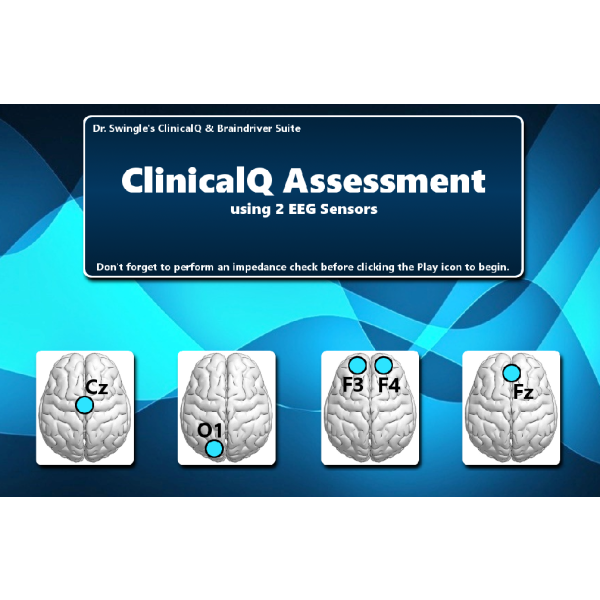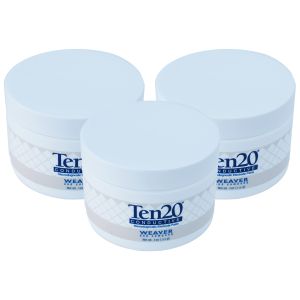This ClinicalQ & Braindriver software suite designed by Dr. Paul G. Swingle includes everything you need to fully implement this method in your practice.
The ClinicalQ Assessment examines brain activity at 5 sites as a basis for determining training plans quickly and effectively. Results from the assessment are arranged in a simple excel report, which includes notes for quick interpretation. The documentation included with the suite guides users through the entire process of hardware hook-up, client preparation, impedance check, data recording and reviewing. Braindriver training screens feature the use of Dr. Swingle’s harmonics that facilitate the therapeutic process by entrainment. Sample data is also included with the software program to allow purchasers to see a real-time recording of a Braindriver session.
Hardware & Software Configurations (Encoders & Channel Sets)
New Features:
- Addition of 5-EEG sensor version of ClinicalQ Assessment (can record from 5 sites simultaneously)
- Overhaul of the ClinicalQ Assessment excel report
- Integration of ClinicalQ Report Writer website tool for analysis of results from the ClinicalQ Assessment excel report
- Removal and simplification of many Braindriver training screens
- Removal of Mini ClinicalQ Assessment
- Implementation of new visual design
Also Included:
- Digital version of Dr. Swingle’s book “Adding Neurotherapy to Your Practice: Clinician’s Guide to the ClinicalQ, Neurofeedback and Braindriving” (found in the suite documents folder)
- Lesson recordings that explain all features of the software suite
- Integration of ClinicalQ Report Writer website tool, that collects data used to generate an optional client report
Works with:
- Procomp 2
- Procomp 5
- Procomp Infiniti 8 Channel
- Flexcomp in Procomp Infiniti mode (dip switch settings changed)
Channel Set
The Quick Q Assessment
The QuickQ assessment protocol (script) is based on Dr. Swingles research and years of clinical experience. The sensor placement for the QuickQ assessment is 2-channel, beginning with CZ, moving to O1 then F3 and F4 (two channel) and ending with FZ. Reference is set to A1 and ground is set to A2.
Although the data collection is sequential, and requires replacement
of sensors during the protocol, the total data recording duration is just under 7 minutes.
The activities during the assessment compromise of interchanges
of eyes-open and eyes-closed recording,along with a single cognitive challenge and a single harmonic sound listening task. The software also contains four harmonic testing protocols, which determine
what harmonic has an effect on the frequency band of interest and if so, what volume produces the most effect for the client. Each harmonic testing protocol plays the specified harmonic at different
volumes, in sequence. The harmonic testing protocols are aptly named Mozart, Omni, Sweep and Serene, based on the harmonic being tested.
The results of the QuickQ assessment and harmonic testing protocols are meant to be used in conjunction with the BrainDryvr neurofeedback retraining strategies also described in the suite manual.
About The Author
Paul G. Swingle, Ph.D., is a Fellow of the Canadian Psychological Association and was Lecturer in Psychiatry at Harvard Medical School from 1991 to 1998. Professor Swingle was Chairman of the Faculty of Child Psychology at the University of Ottawa from 1972 to 1977 and Clinical Supervisor from 1987 to 1997. He has also taught at McGill University, Dalhousie University and McMaster University. He is a Registered Psychologist in British Columbia and is (BCIA) Certified in Biofeedback and Neurotherapy.
Since 1997 he has been in private practice in Vancouver, British Columbia. His most recent book Biofeedback for the Brain (2008) was published by Rutgers University Press.
BrainDryvr Training
After recording a QuickQ assessment, the results have been formulated using the QuickQ Excel Report and a treatment plan prepared, BrainDryvr neurofeedback training can begin. The BrainDryvr neurofeedback training display screens are preset to focus only on one or two standard EEG bandwidths.
Training can consist of rewarding or inhibiting a bands amplitude. When the trainee successfully achieves a frequency bandwidth amplitude above or below an automatically-set threshold, feedback occurs in terms of a light activating, tones being heard or an animation moving. Epoch means are displayed on all screens, so that within session progress can be tracked by clinician and client. Each open training session can be saved and reviewed if necessary.
Progress over multiple sessions can be graphed using the trend reports, excel reports or recording another QuickQ assessment. The number of screens available can be overwhelming at first, but once you are used to the naming convention and their arrangements, their application will be very simple and obvious.
Cautions
It is strongly recommended to refer to Basic Neurotherapy: A Clinicians Guide or other clinical books for more information on the clinical interpretation of the QuickQ assessment results and treatment planning. For more information on the effect of the harmonics on assessment and training, refer to Subliminal Treatment Procedures: A Clinicians Guide by Paul G. Swingle, Ph.D.





